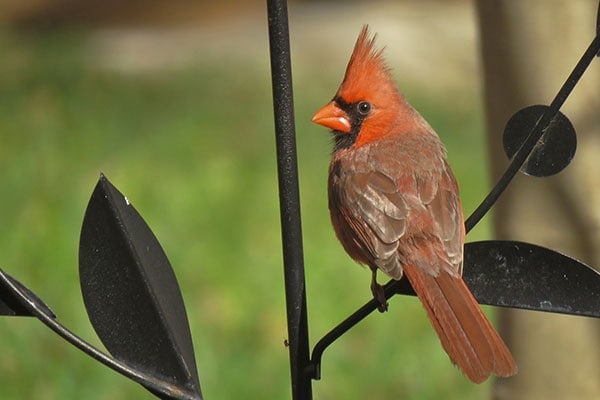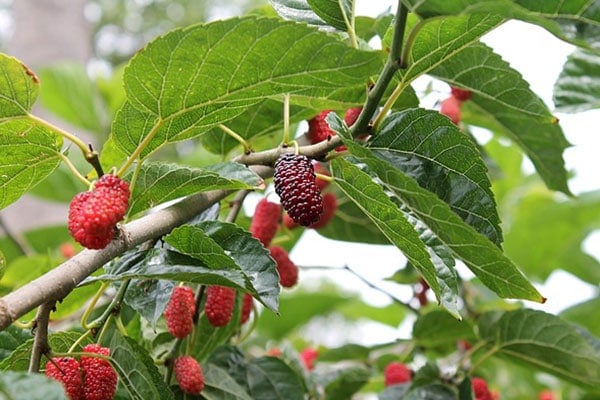Contents
I’m here to tell you that attracting cardinals to your backyard is easier than you think. Cardinals are my favorite birds and I’ve done tons of research to figure out how to get them to come to my backyard. It isn’t voodoo and it isn’t magic. Trust me. I know.
So, what plants attract cardinals? If you’d love to see the beautiful redbirds in your backyard then you’re going to want to plant purple cornflower, grapes, milkweed, honeysuckle, chili piquin, virginia creeper, sunflowers, elderberries, and serviceberries.
I’ve always thought cardinals were the prettiest birds. I love their red plumage and wanted to know how to attract more of them to my yard. So, I took it upon myself to figure out how to get them in my backyard and started my research.
So, listen up, cardinal lovers.
In this article, you’ll learn…
What kind of plants you should have in your backyard to draw Cardinals to build a nest
Which plants provide cardinals with natural adequate food supplies.
How to get Cardinals to stay in your backyard with strategically placed plants and nesting ledges.
So, how do you get started?
Simple. Read on!
You’ll find out:
- What plants make them feel the safest
- What plants offer food sources
- What type of food they enjoy most
- Where to place nesting ledges
- What to avoid

What Plants Will Best Attract Cardinals?
Believe it or not, every bird has its quirks and likes and dislikes. It might seem a bit like a blind date trying to figure out what to do and not to do to make an impression. Well, thanks to having my research in hand, it won’t be like that at all.
One basic guideline to keep in mind is to try and grow plants that are native to the geographic location and climate within which you live. It is too hard to try and grow plants that are from different climates. They typically require a great deal more care and fertilizers and feed to get them to grow and flourish.
One thing to keep in mind, in addition to planting the best flower, & shrubs to attract Cardinals, you can also provide food for them by using the best bird feeders designed for Cardinals.
Natural Plants
Birds and plants are naturally linked and thanks to evolution, they have learned to rely on one another to help each other. The colorful fruits and abundant seeds lure birds with a sweet natural food source and spread the seeds supporting the ecosystem and ensuring themselves with a food supply the next season.
Another way cardinals benefit from having natural plants nearby is that they also draw protein-rich insects such as butterfly and moth caterpillars which cardinals use to feed their brood. Birds oftentimes change their entire life cycles including where they live or migrate to based on the availability of seasonal fruits and insects. And while cardinals don’t migrate, they do nest in an environment where they have plenty of food.
So, how do we cash in on this phenomenon and get cardinals to come to our yard? By cultivating the proper plants, you can ensure cardinals in your backyard each and every season.
Plants to Cultivate for Food and Shelter
The best plants to cultivate in your backyard are:
- Chili Piquin
- Mulberry Tree
- Grapes
- Virginia Creepers
- Purple Coneflower
- Sunflowers
- Service Berries
- Elderberries
One of the plants that draw cardinals is Chili Piquin. Birds of all types love these peppers but especially cardinals. It is so beloved by birds, its nickname is ‘bird-eye pepper’. This plant does well in either sunny or partly shady areas.

The mulberry tree is one tree that cardinals love but it can be somewhat messy for sidewalks or cards. It is a hardy tree that does well in either shady or sunny locations. Cardinals love them for their fruit and as nesting locations because of their branch and leaf cover.
Grapes can also provide a great food source for cardinals as well as a place to nest. Their ‘shredding bark’ can be used to build nests and help with cover.
A native tree-climbing vine, it provides fruit for the cardinals in autumn. The plan becomes bright scarlet when it develops fruit. It offers shelter from predators and an excellent location for nesting.

The purple coneflower produces seed which is a big food source for cardinals especially in winter when insects and fruit can be scarce. They too provide shelter and potential nesting sites for the red birds.
It is truly an amazing sight to watch as cardinals cling to the face of the sunflower while picking out the seeds from the middle of the sunflower’s face. Those beautiful yellow flowers adorned with bright red cardinals is truly a sight to see. They are almost like a natural bird feeder in your backyard.

We know that cardinals enjoy eating fruits from various plants, one they absolutely love is elderberries and serviceberries. These are either considered large shrubs or small trees based solely on how big they are. Cardinals love the fruit and as a bonus, they also love the flowers on the elderberry shrubs. They attract a wide array of insects to which cardinals are always drawn.
How Do I Provide Shelter for My Cardinals?
As with all living creatures, cardinals crave three central things to be content and to thrive. If those three things are met, then they will stay put for the entirety of their lives.
Basic needs for cardinals:
Most birds will gladly build a nest in any birdhouse placed in the backyard but not cardinals. No, they are a little pickier than most birds. They will not build their nest in birdhouses. They feel too enclosed with no ready way to escape save the one entrance.
Plants That Attract Cardinals to Nest in
Planting a variety of plants to offer cardinals multiple locations within which to nest and to feel safe around the backyard would be a great idea. Since cardinals don’t nest in the same nest season after season, they will constantly be looking for another nesting site. If they have multiple ones to choose from they are more likely to stick around your backyard.
They like nesting in clematis, hawthorn, dogwood, grapevines, and shrub thickets. It is also a good idea to have other plants and trees around which could provide materials for cardinals to use to build their nests. This would include pine needles, grass clippings, and twigs.
By giving them several dense pockets of foliage to choose from, you can ensure that your cardinals will stake a claim to your backyard and stick around.
Nesting Shelves
While cardinals do not care for birdhouses with their closed design, they are drawn to nesting shelves. These are three-sided structures with no roof and sturdy floors. With the open design, cardinals will be drawn to build on it. To improve the chances of cardinals nesting on it, I would strongly suggest placing it inside some cover. This cover could be thick bushes or undergrowth and while it might seem counterproductive from a bird watcher’s point of view to put a nest inside of bushes it makes sense to the cardinals. They will feel safe and have a nesting ground nearby to your feeder, meaning they will stick around for years.
Things to Avoid
Reflective surfaces will drive cardinals insane. They are incredibly territorial and if they spot their reflection in a window they will attack it, thinking it is another cardinal trying to take over their territory. To take care of this, those windows should have screens attached to the outside so they are not quite so reflective.
Our Final Thoughts On Plants That Attract Cardinals
The good news is once you have created a perfect space for your cardinal family, they will keep coming back year after year. With a lifespan of up to 15 years, you’ll have countless hours of enjoyment watching them feed and raise their babies. Use the information in this article and reap the benefits of my research to make a wonderful cardinal-friendly backyard.
Happy watching!

